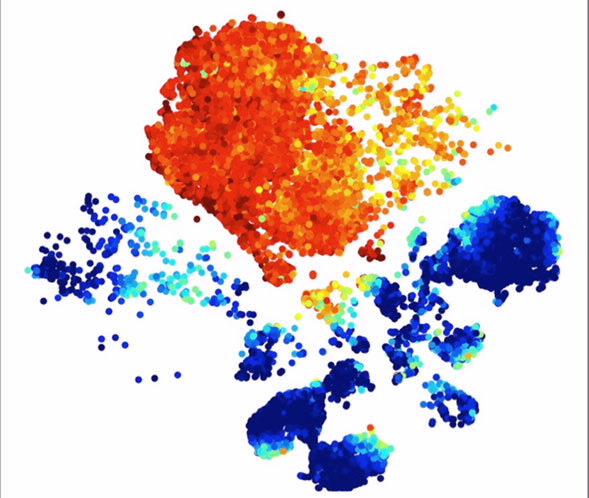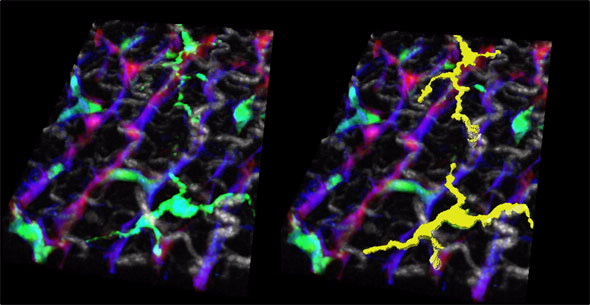Newly recruited immunologist and cellular biologist, Dr Frederic Sierro, who recently joined the Human Health research group at ANSTO, is convinced that a thorough understanding of the complex cellular players and activities of the immune system may be the key to many illnesses.
The immune system has been implicated in the regulation of many diseases, including non-infectious, non-communicable ones,” said Sierro, who will be exploring how food and nutrition contribute to the prevention of disease and maintenance of good health.
 |
And although there have been significant advances in immunology in deciphering the numerous functions of the immune system—protection against disease, infection and cancer, maintaining healthy flora equilibrium, recognising self, etc—there is still a lot to be learned due to its inherent complexity.
Sierro (pictured right), who previously worked at the Garvan Institute and Centenary Institute in Australia after completing studies in Switzerland, has a longstanding interest in gaining insights into the functioning of the immune system using single cells, the basic unit of the immune system.
The human immune system is comprised of an innate system, which responds to “danger signals” associated with foreign bodies, injuries or pathogens and an acquired system, which responds highly specifically to specific molecules or parts of called antigens, produced by pathogens or changed cells, to which they can induce a long term immunological memory.
There are many different types of cells in the immune system and they are broadly segregated between these two systems.
Key players in the innate immune system are the phagocytes–macrophages, neutrophils and natural killer cells that respond quickly and rather indiscriminately but can also cause collateral damage.
In contrast, the acquired immune system comprises the antibodies-producing B cells and the T cells that include cytotoxic or “killer” CD8 and “helper” CD4 cells. CD4 cells are central because they are involved in the regulation/orchestration of most other immune cells.
Another key innate immune cell type is the dendritic cell that “presents” antigens to T cells and thus bridges innate and adaptive immunity. All of these immune system cells have subsets with slightly different functions.
We have cells that recognise danger associated molecular patterns rather indiscriminately and those that can recognise one antigen in a million or more.
Steps in the immune response happen in different places and time. Many immune cells are highly mobile and the migration, interactions of these cells with each other and with other cells in the body has to be highly regulated to respond to challenges without inducing too much damage.
"If you take a piece of lymph node, you have many different types of cells, really close or interacting with each other, whose functions, activities and regulation are not thoroughly understood,” said Sierro.
"If you want to make sense of the heterogeneity of an organ, which is made up of a large number of different cell types all interacting and highly motile, you have to take snapshots and have a reasonable understanding of what is happening within each single cell.
As there can be in excess of 5000 different types of proteins in any one cell at a given time, this is not a simple task and you must go beyond the limits of the flow cytometry used today.”
 |
| t-Distributed Stochastic Neighbor Embedding (t-SNE: machine learning algorithm for dimensionality reduction) visualization of immune cells stained for 30 parameters. Each dot represents a cell and clusters represent cells that are similar in this multi-dimensional space, thus revealing discrete cell subsets |
Cellular biologists use this technique to identify cell populations but are restricted to the number of parameters that can be quantified.
"We can go up to 12 easily but past 18 is really difficult with actual fluorescence-based techniques.”
Sample preparation and processing can also introduce errors or roadblocks.
"There are also potential flaws in that you can’t identify where the populations were located in the organ nor the cells with which they were interacting after isolating single cell preparations.“
Many immunologists are moving back to approaches using advanced microscopy and imaging, such as two photon microscopy, in vivo imaging, imaging using synchrotron X-rays and mass spectrometry based imaging.
Some of these new imaging techniques have proven to be highly useful in identifying new populations of cells.
Sierro sees the potential of using specialised radiolabelling techniques as well as rare isotopes, such as those developed at ANSTO by human health and other researchers, to further characterise subsets of immune cells and their activity.
Novel macrophages in the liver
Prior to joining ANSTO, Sierro spent a number of years working with immune cells present in the liver. The liver is a big detoxification organ and it has a role in metabolism. In one study, Sierro investigated liver macrophages because there was controversy about the diverse and divergent functions attributed to them.
Macrophages act like big sponges detecting, engulfing and killing pathogens but are also thought to have a role in starting inflammation as well as being essential for injury repair.
There were these cells expressing molecular markers of both dendritic cells and macrophages.
"We tried to identify the markers able to discriminate between these two populations and others.”
Cells at the surface of the liver seemed to fit the profile of macrophage/monocytes rather than dendritic cells.
 |
| Newly described liver macrophages: 3D reconstruction of multiphoton acquisition of the top layer of a murine liver. Red: blood tracer, blue: sinusoidal endothelial cells (liver blood capillaries), green: Green fluorescent Protein expressed in all myeloid cells. Liver capsule macrophages highlighted in yellow (left panel) |
Further, using a combination of flow cytometry and live 2-photon imaging techniques, Sierro’s research provided evidence that this previously undescribed macrophage population at the surface of the liver monitors the environment of the peritoneal cavity in part by recruiting other phagocytic (killer) cells.
Immunotherapy for cancer
The immune system is being extensively studied in cancer research because the immune system has a role in destroying cells that are transforming into cancerous cells. Tumour cells express ligands that bind to immune inhibitory receptors as part of a strategy to escape the immune response.
This has been exemplified recently by the success of immunotherapy in the treatment of specific cancers such as melanoma in which treatments involve blocking the binding of such inhibitory ligands.
However, still only 20 to 40 re cent of melanoma patients respond to actual immunotherapies.
These treatments have side effects so it would be better to know in advance if it might be better to use another treatment if patients are not going to benefit from immunotherapy. This is the space where new PET tracers could have a lot of impact,” said Sierro.
There is a need for more tools, to stratify patients in order to identify who will respond to immunotherapy before treatment is commenced.
Also monitoring the response to therapy using novel PET tracers would be valuable, because it is well known that present tracers like FDG cannot discriminate well between immune cells activation and tumour cell metabolism.
Metabolism
Metabolic activity has been identified as an important area of investigation in immunology.
The immune system is well known to regulate systemic metabolism and in more recently metabolism at the cellular level is now considered one of the big regulating or polarising mechanism in the function of immune cell subsets,” said Sierro.
In a recent study with collaborators at Prince of Wales Hospital in Sydney, Sierro undertook research on the role of immune cells in gestational diabetes.
Women who develop gestational diabetes are 5 to 10X more likely to develop Type 2 diabetes later in life than women who have a normal pregnancy.
"We found that there was a long lasting immune imbalance in women who had gestational diabetes and we now have to investigate if there is a link between this and the long term risk of developing Type 2 diabetes.
Depending on the context of immune cells development or activation, in terms of cytokines, metabolism, and co-stimulatory molecules, you end up with a different regulation of these cells function.
The survival, maintenance and functional polarisation of these cells relies on the metabolism the cells follow or are forced to follow, due to availability of nutrients for example.”
Clinicians are trying to modify the diets of pregnant women in an attempt to prevent diabetes. In this particular case and also for a wider range of conditions, these interventions could not only influence systemic metabolism directly but could also have a profound impact on immune cells functions.
We could potentially use the tracer compounds that are produced by the radiochemistry group here to identify immune cells metabolic status simultaneously with their phenotype, said Sierro.
Going forward
As research leader in Human Health, Frederic Sierro now turns his main focus on food, nutrition and health. “How food and diet manipulation can affect key development steps as well as pro- versus anti-inflammatory education of the immune system is becoming an intense area of research.
The advent of new food processes and formulations presents both dangers and opportunities. Thus, in the field of food science and function, the unique capabilities available in ANSTO, such as the characterisation of materials as well as the generation of traceable compounds offer unique possibilities to link back the beneficial or detrimental effects of specific food components on immune resilience to their biodistribution, retention and highly characterised physicochemical properties,
One of the main priorities of our Human Health strategic research is increasing the understanding of the key processes related to immune response that are involved in maintaining good health or developing long-term disease.
“This is an area where Frederic’s expertise will be invaluable,“ said Dr Marie Claude Gregoire, Leader of Human Health.
Published: 16/11/2017


